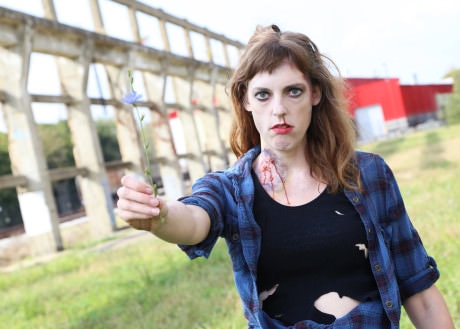“I’m not dead, I’m just hurt real bad,” says Regina, a young woman whose life is a painful wreck, a sorry mess. She’s homeless, rejected and shut out, even by her mother. She is an outsider so alien to everyday human society that to others she seems a zombie. But performance artist Rachel Hynes, who plays Regina and who conceived Regina’s life crisis as a devised theater piece, wants us to get to know her up close and personal. The unnerving and compelling result is Half Life (a zombie love letter for no one), an artfully in-your-face encounter with someone so damaged she is on the verge of living death.

We sit in the small Mead Theatre Lab black box on either side of a playing area with a disassembled old car at one end and assorted auto parts hung from plastic sheeting overhead, the detritus of despair (Scenic Designer Brian Gillick and Lighting Designer Mary Keegan have created a haunting, almost post-apocalyptic world). “Mama, I crashed the truck,” says Regina sorrowfully as Hynes’s angular body agonizingly portrays the character’s near-death injury, dragging a wounded leg, horror on her lipstick- and eyeshadow-smeared face, her clothing torn (Costume Designer Brittany Graham strikes an intriguing style somewhere between punk and funk). Desperately Regina seeks safety and solace that seem always out of reach. When Regina tries without success to hitch a ride, the sounds of trucks vrooming by turn the playing area into a superhighway and her desolation sinks in further.
More than once I winced at how precisely Hynes (together with Co-Devisors Jonathan Lee Taylor, Tyler Herman, and Joshua Drew) have created image after image reminiscent of every destitute, hollow-eyed homeless person one has seen (or not seen) on the street. At its core the vision of Half Life is extraordinarily bold and daring: to put onstage a dramatic portrait of a person who is, for all practical purposes, a nonperson—just like all those nameless people in public places whose presence rebukes our comfort. And kudos to Cultural DC for housing this fearlessly unsentimental evocation of homelessness.
Though the character Regina lives in a kind of terminal isolation, Hynes herself shares the stage with Taylor, who plays several roles, including a goth bartender who befriends her and Regina’s shrill mother who doesn’t. Together Hynes and Taylor do some eloquent pas de deux as well (Choreographer Nora Rosengarten has really pushed them both, to arresting effect). The sound design, along with original music by Cex (Rjyan Kidwell), served to propel the storytelling, which was somewhat fragmentary as befits the main character’s fractured mental state.

This is definitely a theater piece that is worth seeing in this its first iteration and worthy of further and deeper development. The powerful imagery and stage presence of the performers is not always well matched by the spoken texts, which seem still in draft. And the fact of Regina’s isolation, which the piece very provocatively makes a point of, is not always congruent with the fact of another performer on stage whose transition from role to role seems random rather than arising out of, or reflecting, Regina’s inner psychic/emotional reality. The structural/dramatic challenge is how to underscore one character’s isolation by counterpoint to other characters’ presence. And that’s the sort of form/content conundrum that this nervy crew of collaborators deserves more opportunity to crack.
Running time: About 55 minutes, with no intermission.
Half Life (a zombie letter for no one) plays through February 21, 2015 at Mead Theatre Lab at Flashpoint – 916 G Street, NW in Washington, D.C. Purchase tickets online.
RATING:




